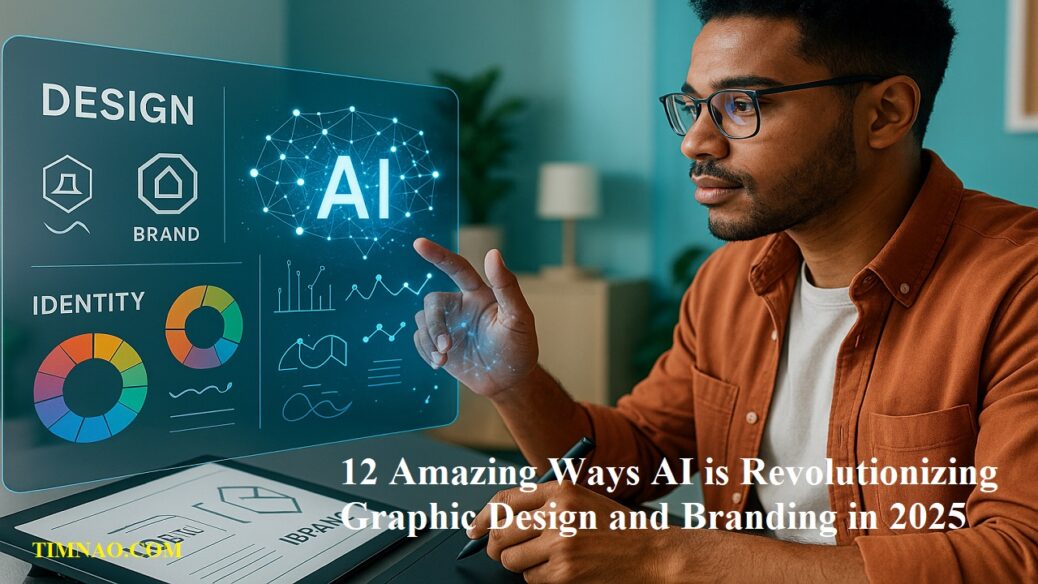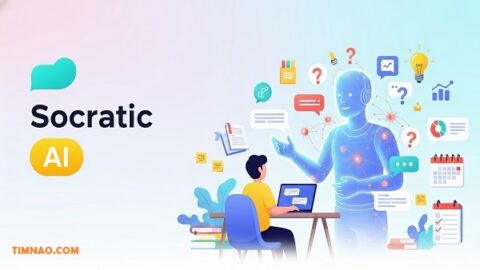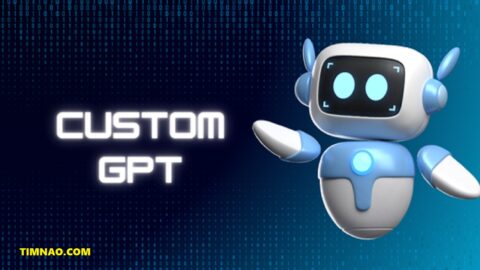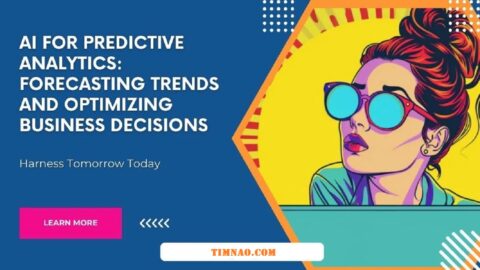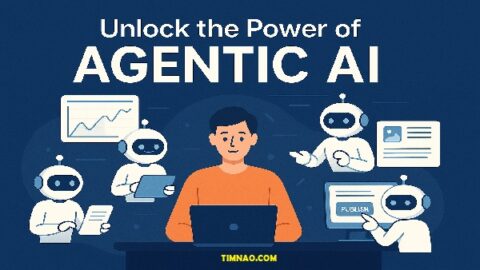12 Amazing Ways AI is Revolutionizing Graphic Design and Branding in 2025
Graphic design and branding are more than just pretty pictures; they’re the visual soul of a business, the first impression, and a powerful communication tool. In today’s crowded digital world, standing out requires creativity, strategy, and, increasingly, the smart use of technology. If you’re passionate about visuals and eager to build a creative business, understanding the synergy between graphic design, branding, and Artificial Intelligence (AI) is crucial.
The world of graphic design is booming! The global market size is estimated to hit a staggering $57.55 billion in 2025, projected to reach $76.62 billion by 2030, growing at a healthy rate of nearly 6% annually. North America currently leads the charge, but growth is global. What’s driving this? Businesses, especially small and medium-sized enterprises (SMEs), recognize that compelling visuals are essential for success. Around 80% of small business owners see graphic design as vital, and 75% of consumers judge a business’s credibility based on its website design alone.
Now, add AI into the mix. AI graphic design isn’t about replacing human creativity; it’s about amplifying it. Tools like DALL-E 3 and Midjourney are no longer just futuristic concepts; they are practical assets for designers. While anyone can dabble with these tools, businesses increasingly seek skilled graphic designers who can expertly wield AI to generate, refine, and optimize visuals. This creates a massive opportunity, especially for freelancers – who make up a significant portion of the industry (one report suggests around 90% of US designers freelance!).
So, how exactly is AI changing the game? Here are 12 amazing ways AI is revolutionizing graphic design and branding today:
- Boosting Efficiency: AI dramatically speeds up workflows by automating repetitive tasks like background removal, image tagging, and suggesting layouts.
- Rapid Concept Generation: AI tools can instantly brainstorm and visualize numerous design concepts based on text prompts, overcoming creative blocks.
- Enhancing Creativity & Innovation: AI introduces novel styles and unexpected combinations, pushing creative boundaries beyond traditional methods.
- Enabling Personalization at Scale: AI facilitates the creation of highly customized designs tailored to specific audiences or allows for rapid generation of design variations.
- Improving Accessibility: Tools like Canva AI and Adobe Express make sophisticated design capabilities more accessible, empowering more people to create visuals.
- Streamlining Complex Tasks: AI assists in complex processes, like generating intricate patterns, enhancing image quality, or even suggesting color palettes and font pairings.
- Facilitating Advanced Visual Experimentation: Platforms like Midjourney and DALL-E 3 allow designers to experiment with cutting-edge visual styles and photorealistic or abstract imagery easily.
- Creating New Service Niches: The rise of AI creates opportunities for designers to specialize in AI-assisted design, prompt engineering for visuals, or AI-driven branding consultations.
- Optimizing Branding Consistency: AI can help analyze existing brand assets and generate new visuals that strictly adhere to established brand guidelines.
- Accelerating Content Creation: AI significantly speeds up the creation of graphics for social media, marketing campaigns, and presentations.
- Generating Unique Branding Elements: AI can produce highly unique and distinctive logos, icons, and other branding assets that stand out.
- Potential for Data-Driven Design Insights: AI can analyze vast datasets to inform design choices, potentially leading to more effective visuals based on audience engagement or market trends.
These advancements highlight why understanding and leveraging AI is becoming essential for modern graphic designers. This article is your deep dive into this exciting intersection. We’ll explore how you can harness these powerful tools, build a thriving creative business, and navigate the evolving landscape in 2025 and beyond.
🚀 The Incredible Opportunity in Graphic Design and Branding Today
The demand for unique and effective visual communication has never been higher. Businesses need logos, websites, social media graphics, marketing materials, presentations, packaging – the list is endless. They need a cohesive branding strategy that resonates with their target audience and sets them apart.
- Market Growth: As mentioned, the market is valued at over $57 billion in 2025 and growing steadily.
- SME Demand: Small and medium businesses are increasingly investing in professional design to compete effectively online and offline. They need help creating everything from logos to email marketing campaigns.
- Freelance Dominance: The rise of the gig economy and the nature of design work make freelancing a popular and viable path. Freelance graphic design offers flexibility and the chance to work with diverse clients.
- Income Potential: While salaries vary based on location, experience, and specialization, average salaries for US-based graphic designers often fall between $60k-$80k annually (though sources like Indeed suggest averages closer to $56k-$60k, and the Bureau of Labor Statistics estimates a median of around $58,910). Hourly rates for freelancers can range widely, often cited between $15-$150, but realistically budgeting $35-$40+ per hour is advisable for experienced freelancers. Specialized skills command higher rates.
The opportunity lies in combining strong design fundamentals with the efficiency and innovative potential of AI graphic design tools to deliver exceptional value to clients.
🤖 AI: Your Astounding New Partner in Graphic Design
Forget the sci-fi fear of robots taking over. Think of AI as the ultimate design assistant, streamlining workflows and unlocking new creative avenues. AI graphic design is one of the hottest trends for 2025, allowing designers to:
- Boost Efficiency: AI automates repetitive tasks like background removal, image tagging, and even suggesting font pairings (thanks to platforms like Adobe Sensei integrated within the Adobe Creative Cloud). This frees up valuable time for strategic thinking and complex creative work.
- Generate Concepts Rapidly: Stuck for ideas? AI tools like ChatGPT or Claude 3 can brainstorm concepts based on text descriptions. Generative AI like DALL-E 3, Midjourney, and Ideogram can translate those ideas into unique visuals almost instantly.
- Enhance Creativity: AI can generate unexpected combinations and styles, pushing creative boundaries beyond traditional methods. It’s fantastic for visual experimentation and creating truly unique branding elements.
- Personalize at Scale: AI can analyze data to help tailor designs to specific audiences or create variations of a design quickly, offering highly customized solutions efficiently.
- Accessibility: Platforms like Canva, with their integrated AI features, make sophisticated design capabilities accessible even to those without deep technical skills, though professional designers leverage these tools for speed and ideation.
The key is integration. AI doesn’t replace the designer’s eye, strategic thinking, or understanding of branding principles. It enhances them.
🎯 Finding Your Sweet Spot: Niching Down in Graphic Design
The world of graphic design is vast. Trying to be everything to everyone is a recipe for burnout. Specializing, or finding a niche, helps you:
- Focus Your Skills: Become a true expert in a specific area.
- Target Your Marketing: Attract the right clients who value your specific expertise.
- Command Higher Rates: Specialists are often perceived as more valuable.
- Build a Stronger Portfolio: Showcase deep expertise in your chosen area.
Consider niches like:
- Industry Focus: Designing for specific sectors like tech startups, restaurants, non-profits, or fashion brands.
- Service Specialization: Focusing on logo design and branding identity packages, web design (UI/UX), social media graphics, presentation design, packaging design, or illustration.
- AI-Specific Services: Offering services explicitly centered around AI graphic design, such as AI-assisted logo generation and refinement, AI-powered social media content creation, or AI concept art for specific industries.
- Style Specialization: Mastering a particular aesthetic, like minimalist design, retro illustration, or corporate branding.
Think about your passions, skills, and where you see market demand. Where can AI graphic design provide a unique advantage within that niche?
🛠️ Your Modern Design Toolkit: Essential AI and Standard Tools
To succeed as an AI-powered graphic designer, you need a blend of traditional and cutting-edge tools:
- AI Idea Generators & Chatbots:
- ChatGPT (OpenAI): Excellent for brainstorming design concepts, writing prompts for image generators, and even drafting design briefs. Integrates with DALL-E 3.
- Claude 3 (Anthropic): Another powerful conversational AI for ideation and text-based tasks, known for its nuanced understanding and large context window.
- AI Image Generation & Design Software:
- Midjourney: A favorite for generating highly artistic and stylized images from text prompts via Discord or their web interface. Great for unique branding visuals and concept art.
- DALL-E 3 (OpenAI): Integrated into ChatGPT Plus and available via API, known for understanding complex prompts and generating detailed, accurate images, including text within images.
- Adobe Firefly (within Adobe Creative Cloud): Adobe’s suite of generative AI tools integrated into Photoshop, Illustrator, and Adobe Express. Designed for commercial safety and seamless workflow integration. Includes features like Generative Fill, Text-to-Image, and Text Effects.
- Canva AI: Canva integrates various AI features (Magic Write, Magic Design, AI image generator) making design accessible and fast, especially for social media and marketing materials.
- Ideogram: Known for its strong ability to generate images with accurate text integrated into them.
- Industry-Standard Design Software:
- Adobe Creative Cloud (Photoshop, Illustrator, InDesign): The professional standard for detailed image editing, vector graphics, and layout design. AI features are increasingly integrated.
- Figma/Sketch: Leading tools for UI/UX design and collaborative interface design.
- Project Management & Collaboration Tools:
- Portfolio Platforms:
- Digital Marketing Tools: Email marketing platforms (e.g., Mailchimp, ConvertKit), social media scheduling tools (e.g., Buffer, Hootsuite), SEO tools (like RankMath for WordPress).
Mastering a selection of these tools, particularly the AI graphic design ones relevant to your niche, is key.
📝 Step-by-Step: Launching Your Awesome AI Graphic Design Business
Ready to turn your passion into profit? Here’s a roadmap:
- Define Your Niche & Services (Again!): Seriously, clarity here is foundational. What specific problems will you solve for which specific clients using your graphic design and AI graphic design skills? Outline your service packages clearly.
- Master Your AI Tools: This isn’t about knowing every single tool, but deeply understanding the ones core to your services. Practice generating images with Midjourney or DALL-E 3. Learn the AI features in Canva or Adobe Express. Experiment constantly. Stay updated – AI evolves fast.
- Build an Irresistible Portfolio: Your portfolio is your most powerful sales tool. Showcase your best work, emphasizing projects where AI played a role (and explain how). If you’re starting out, create mock projects for fictional clients or redesign existing branding to demonstrate your skills. Feature diverse examples within your niche. Host it professionally on your own website and platforms like Behance or Dribbble.
- Set Up Shop (Legally & Financially):
- Legal Structure: Decide if you’ll operate as a sole proprietor, LLC, etc. (Consult local regulations and possibly a legal advisor).
- Branding: Yes, you need your own branding! Design your logo, business cards (digital or print), and website.
- Finances: Open a separate business bank account. Use accounting software (e.g., QuickBooks, FreshBooks, Wave) to track income/expenses and manage invoices. Understand your tax obligations.
- Market Yourself Like a Creative Genius:
- Online Presence: Be active where your potential clients hang out (LinkedIn, Instagram, Pinterest, specific industry forums). Share your work, insights, and process.
- Content Marketing: Start a blog, create video tutorials, or share design tips related to your niche and AI graphic design. Position yourself as an expert.
- Networking: Engage in online design communities. Attend virtual or local industry events. Connect with potential collaborators and clients. Referrals are golden.
- Price Your Services Smartly:
- Research: Understand market rates for your niche and experience level. Look at freelancer platforms (like Upwork, Fiverr – but use their rates as a guide, not a definitive value), agency pricing, and subscription services (ManyPixels is one example).
- Pricing Models: Consider hourly rates, project-based fees, or retainer agreements for ongoing work.
- Value: Don’t just charge for time; charge for the value and results you deliver. As your portfolio and testimonials grow, increase your rates.
- Platforms: Consider selling pre-made templates or assets on marketplaces like Etsy, Creative Market, or Envato (like ThemeForest or Envato Elements).
- Deliver Excellence & Efficiency:
- Project Management: Use tools like Trello, Asana, or Notion to keep projects organized, track deadlines, and manage client communication.
- Communication: Keep clients informed throughout the process. Understand their vision clearly from the start. Manage expectations, especially regarding revisions.
- Quality: Consistently deliver high-quality work that meets or exceeds client expectations. This builds trust and leads to repeat business and referrals.
- Embrace Lifelong Learning: The design world, especially with AI graphic design, changes rapidly. Dedicate time to learning new tools, techniques, and branding trends. Take online courses, watch webinars, read industry blogs, and experiment.
- Focus on Sustainable Growth:
- Build an Email List: Capture leads from your website and nurture them with valuable content and offers.
- Prioritize Client Relationships: Excellent service leads to retention and referrals – often your best source of new business.
- Diversify Income (Optional): Consider creating digital products (templates, courses), offering coaching, or exploring affiliate marketing related to design tools.
⚖️ The Balancing Act: Pros and Cons of AI in Your Design Business
Integrating AI graphic design offers significant advantages, but it’s not without challenges:
Pros:
- ✅ Speed & Efficiency: Automate tedious tasks, freeing up time for creativity and strategy. Handle more projects simultaneously.
- ✅ Innovation Boost: Generate novel concepts and styles you might not have considered. Offer truly unique branding.
- ✅ Scalability: AI tools help manage increased workloads without proportional increases in time or cost, facilitating business growth.
- ✅ Data-Driven Personalization: Leverage AI insights (if applicable) to create designs tailored to specific audience demographics or preferences.
- ✅ Enhanced Capabilities: Achieve complex effects or styles more easily than with traditional methods alone.
Cons:
- ⚠️ Learning Curve: Mastering AI tools and integrating them effectively into your workflow takes time and effort.
- ⚠️ Overreliance Risk: Relying too heavily on AI can potentially stifle personal creative development. Finding the balance between AI assistance and human artistry is key.
- ⚠️ Initial Costs: Subscriptions for multiple AI tools and potentially more powerful hardware can add up.
- ⚠️ Authenticity Concerns: Some clients might be skeptical about AI-generated designs. You’ll need to educate them on the value of AI assistance versus pure AI generation and emphasize the human strategy and refinement involved.
- ⚠️ Ethical & Legal Gray Areas: Questions around copyright, originality, and algorithmic bias in AI-generated content are still evolving. Stay informed about best practices.
💰 Budgeting for Your AI Design Venture: What’s the Investment?
Starting an AI graphic design business can be relatively low-cost compared to brick-and-mortar businesses, but there are expenses:
- AI & Design Software: Subscriptions are the main recurring cost. Expect anywhere from $10-$50+ per month per tool for premium AI features (e.g., Midjourney, ChatGPT Plus, Adobe Creative Cloud). Total software costs could range from $30 to $100+ per month initially, growing as you add more tools.
- Hardware: A reliable computer capable of running design software is essential.
- Website & Hosting: Domain name registration and website hosting fees.
- Marketing: Budget for potential advertising, content creation tools, or networking events.
- Business Registration/Legal Fees: Costs associated with setting up your legal structure.
- Education: Investing in courses or workshops to stay updated.
Carefully budget these costs when setting your pricing.
🧠 The Skillset for Success: Beyond Pixels and Prompts
Thriving in the age of AI graphic design requires a blend of creative, technical, and business skills:
- Strong Graphic Design Fundamentals: Understanding color theory, typography, layout, composition, and visual hierarchy remains paramount. AI is a tool; design principles are the foundation.
- AI Tool Proficiency: Competence in using relevant AI tools (Midjourney, DALL-E 3, Adobe Firefly, etc.). This includes prompt engineering – knowing how to talk to the AI to get the desired results.
- Branding Strategy: Understanding how visuals connect to overall business goals, target audiences, and market positioning. You’re not just making images; you’re building brands.
- Client Communication & Management: Clearly understanding client needs, managing expectations, presenting work effectively, and handling feedback professionally.
- Marketing & Sales: Knowing how to promote your services, attract clients, and close deals.
- Adaptability & Continuous Learning: A commitment to staying updated on both design trends and AI advancements is non-negotiable.
- Critical Thinking & Curation: Evaluating AI outputs, selecting the best options, and refining them with a human touch.
📈 Tracking Your Trajectory: Key Metrics for Growth
How do you know if your freelance graphic design business is succeeding? Track these Key Performance Indicators (KPIs):
- Client Acquisition Cost (CAC): How much does it cost (in time and money) to land a new client? This helps evaluate marketing effectiveness.
- Project Completion Rate (On Time): What percentage of projects are delivered by the deadline? Crucial for client satisfaction and reputation.
- Average Revenue Per Project/Client: Are you increasing the value derived from each engagement through upselling or focusing on higher-value services?
- Client Retention Rate: What percentage of clients come back for more work? High retention indicates satisfaction and quality service.
- Design Revision Count: How many rounds of revisions does a typical project require? Fewer revisions often mean clearer communication and understanding upfront, leading to greater efficiency and satisfaction.
Monitoring these KPIs helps you understand what’s working, identify areas for improvement, and make informed decisions for growth.
🤔 Is This AI-Powered Creative Path Your Perfect Fit?
Starting an AI graphic design and branding business is exciting, but it’s not for everyone.
This might be perfect for you if:
- You have a passion for visual communication and brand storytelling.
- You’re genuinely excited about leveraging AI to create innovative and efficient designs.
- You see the potential of AI to personalize and scale creative solutions.
- You have an entrepreneurial spirit and enjoy consulting with clients on their branding needs.
- You enjoy continuous learning and adapting to new technologies.
This might not be the best fit if:
- You strongly prefer traditional, hands-on design methods and feel AI detracts from the craft.
- You worry AI might depersonalize client interactions, which are very important to you.
- The thought of constantly learning new AI tools feels overwhelming rather than exciting.
- Your primary interest lies in other areas like writing or marketing, where design is secondary.
The Future is Collaborative: Human Creativity + AI Power
The integration of AI into graphic design and branding is not a fleeting trend; it’s the evolution of the creative process. It offers incredible opportunities for efficiency, innovation, and building a successful freelance graphic design business. By mastering the tools, honing your design and business skills, and embracing continuous learning, you can position yourself at the forefront of this exciting field.
Ready to start your journey? The blend of human creativity and artificial intelligence is waiting for your unique touch. Go create something amazing!
Reference video:

